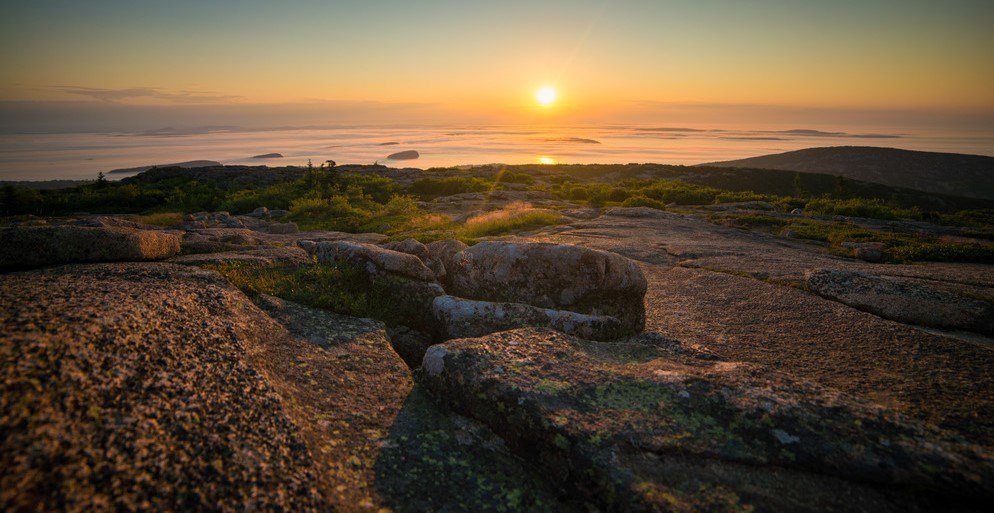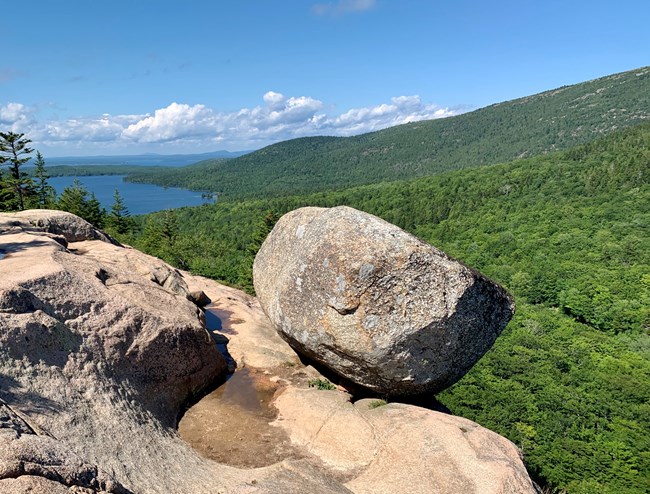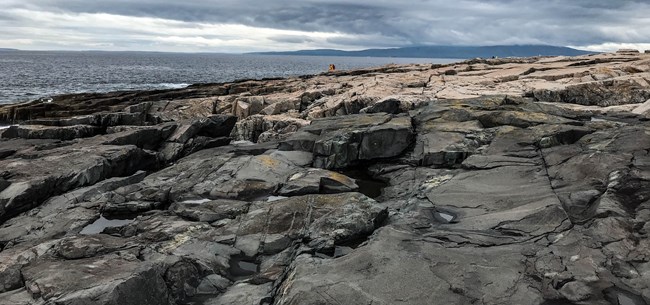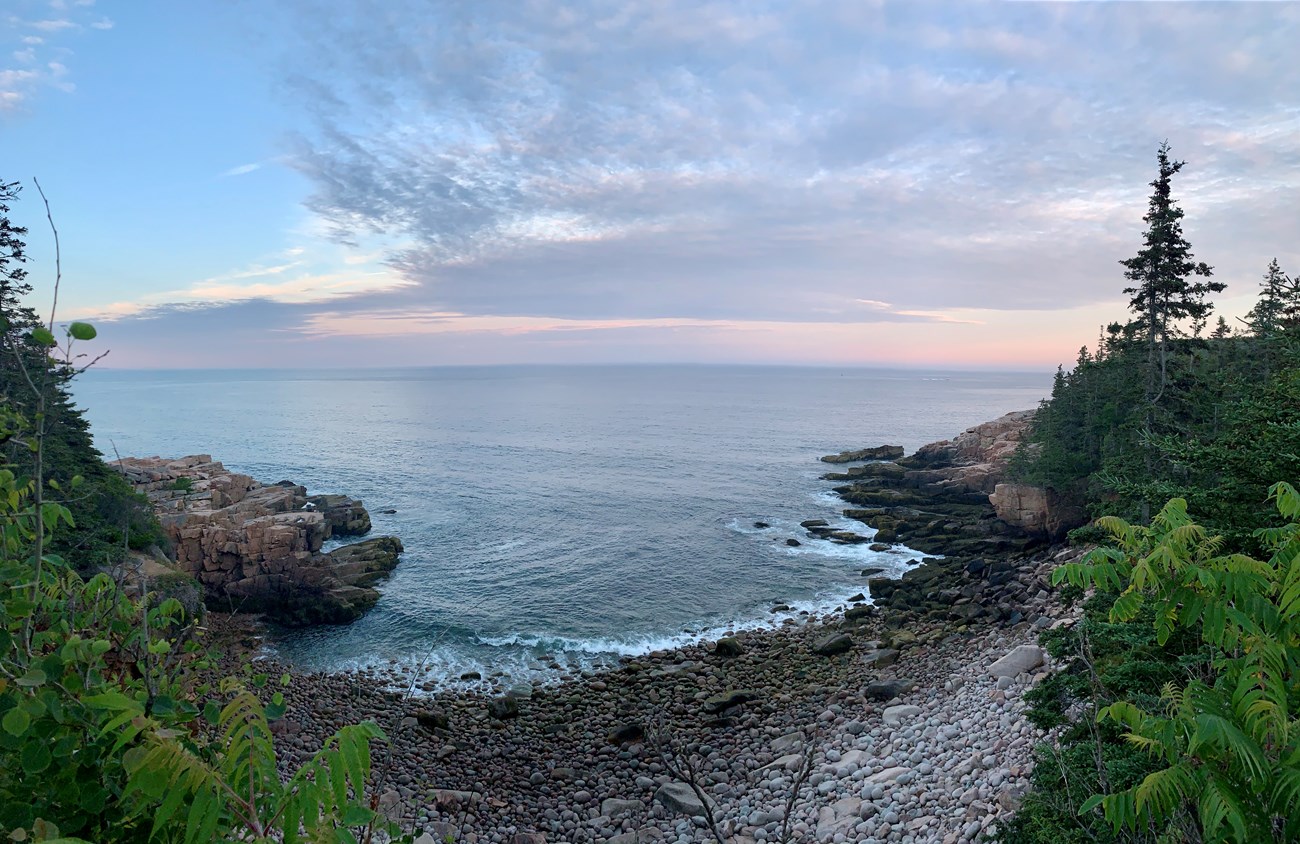|
Barren mountain tops, striking pink granite, u-shaped valleys, narrow lakes...
Acadia's landscape tells the tale of a time when fire and ice covered these lands. 
Photo by Emma Forthofer, Friends of Acadia The geologic history of Acadia National Park stretches back in time through millions of years to the formation of the oldest rocks on Mount Desert Island and continues to the present with the persistent forces of erosion. Evidence of this rich geologic past can be seen in geologic features and formations across the island, along rocky shorelines and atop windswept mountains. Laying the FoundationThe landscape that we know as Acadia had its beginnings more than 500 million years ago, when mud, sand, and volcanic ash were deposited in an early ocean. With time these sediments were buried, and pressure turned them to rock. Forces deep within the earth and tectonic activity deeply buried, heated, and squeezed this rock, changing it into the Ellsworth Schist, a metamorphic rock characterized by contorted, thin bands of white and gray quartz and feldspar, and green chlorite. It is the oldest rock known in the Mount Desert region. The combined forces of erosion and the shifting of the rigid plates that make up the earth’s crust (tectonics) brought the deeply buried Ellsworth Schist to the earth’s surface. Approximately 450 million years ago, when a micro-terrane (mini-continent) called Avalonia collided with North America, this schist formed a platform on which sand and silt accumulated. Burial hardened these fine-grained deposits, creating the Bar Harbor Formation, a sequence of brown to gray bedded, or layered, sandstone and siltstones. Simultaneously with the creation of the Bar Harbor Formation, volcanoes erupted in the region. Volcanic flows and ash accumulated in the ocean basin, and formed the light-colored Cranberry Island Volcanics and deposited layers of ash in the developing Bar Harbor Formation. The granites of Mount Desert Island are approximately 420 million years old. Because their mineralogy is so similar, the granites are identified by the size of individual mineral grains and the composition of the scattered dark minerals present. One of the oldest granites to appear was the Cadillac Mountain Granite, the largest granite body on the island. It oozed up through existing rocks, stressing and fracturing the overlying bedrock and causing large chunks to fall into the molten magma body. Some chunks of bedrock melted in the intense heat, while others were suspended in the magma. When the granite cooled deep in the earth, these blocks remained, surrounded by crystallized granite. This region of granite and broken rock, called the shatter zone, is still visible on the eastern side of the Cadillac Mountain Granite. A medium-grained granite formed to the west of the Cadillac Mountain Granite. Later volcanic activity injected diabase, a fine-grained, black igneous rock into the granites and surrounding rocks. These diabase bodies, or dikes, can be seen along the road to the summit of Cadillac Mountain and on the Schoodic Peninsula. Little record of the following several hundred million years remains. Erosion wore away the rocks covering the large granite bodies, bringing them to the earth’s surface. The same process removed much of the softer rock surrounding the granite, leaving behind resistant granitic mountains ringed by lowlands. Streams ran between the ridges, and a succession of plant and animal life inhabited the region. 
NPS/Kylie Caesar Evidence of IceEvidence from many parts of the world suggests that a succession of ice sheets flowed across northern North America during the last two to three million years. Each glaciation removed traces of previous ice sheets, leaving a record of only the last ice sheet to move through the region. The glaciers eroded the mountains and cut broad U-shaped valleys. Materials carried at the base of the ice polished the mountains and left long scratches (striations) and crescent-shaped gouges (crescentic gouges) in many places. This episode, called the Wisconsin Glaciation, reached its maximum extent 18,000 years ago with its terminus far to the south of Maine. As the climate warmed, more ice melted in the warmer months than accumulated in the winter. Although ice continually flowed south from more northern portions of the ice sheet, the southern edge of the glacier began to recede, depositing material carried by the glacier. Accumulations of rock, gravel, and sand dammed valleys. Boulders carried 20 miles or more were left behind by the melting ice. These glacial erratics are found in valleys and on mountaintops. A carpet of glacial debris was spread out upon the landscape. 
NPS/ Kent Miller What We See TodayThe varied landscape of Acadia National Park is the result of continuing geologic processes. The weathering of granite ridges is one such activity. Large joints, or fractures, in the rock form square blocks. The joints enlarge and expand when water fills them and freezes. Eventually the rock breaks away from the cliff, leaving behind granitic rubble and bright pink scars on precipitous rock faces. The cliffs above the Tarn, south of Bar Harbor on Route 3, show evidence of this activity. Along the coast, the sweep of tides and waves continually shapes the shoreline. Rocky headlands bear the full brunt of the wind and waves of the open ocean. Salt marshes, rich with life, grow in protected tidal valleys, while beaches occupy sheltered coves. Many different types of beaches are found on Acadia’s shores. The size of material composing the beach depends on the energy of the waves that create it. Coves protected from strong wave action are made up of fine-grained material, such as Sand Beach. Beaches facing the open ocean and only minimally sheltered by rocky headlands consist of pebbles, cobbles, and even boulders. The stronger the wave action, the larger the material the waves can carry. In the case of a beach open to the storm-driven waves of the Atlantic Ocean, only the largest boulders remain. 
NPS/ Kylie Caesar The source of the beach material varies. In some places, glacial debris is washed in by the waves, and finer material is removed, leaving cobbles and pebbles to be rolled and rounded by the surf. Sea cliffs can provide beach material, such as large, rounded boulders. Sand Beach is composed primarily of bits and pieces of the shells and hard parts of marine life, such as mussels and sea urchins. Acadia’s landscape is the product of great expanses of time. Massive geologic forces—mountain building, molten magmas, and huge ice sheets—formed the landscape, while the persistent forces of erosion—water, wind, and waves—ever so slowly continue to shape what we see today. What Will We See Next?In the most recent geologic period, humans have had the most dramatic effect on Acadia's landscape. Learn more about the ways we are continuing to shape Acadia National Park and the changes we are seeing. |
Last updated: March 30, 2022
